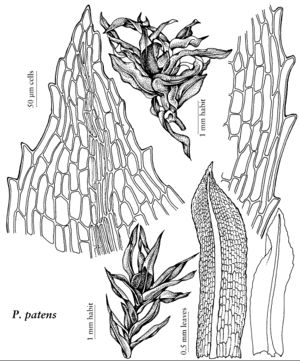Physcomitrella patens
Bryol. Europ. 1: 13. 1849,.
Plants to 5 mm. Stems to 3.5 mm. Leaves to 2.5 × 1 mm, lanceolate or ovatelanceolate to obovate, acuminate, not or weakly concave, margin of lanceolate leaves somewhat reflexed when dry, serrulate in distal 1/3, rarely below leaf median; costa ending near apex; proximal cells 65–135 × 15–45 µm, distal cells 36–66 × 12–27 µm; marginal cells sometimes longer that medial laminal cells, reaching 150 µm. Calyptra entire at base. Spores 21–33 µm.
Phenology: Capsules mature Aug–Jan.
Habitat: Early pioneer on wet mineral soil, river banks, fields
Elevation: low to moderate elevations
Distribution

B.C., Ont., Que., Calif., Ill., Ind., La., Md., Mich., Minn., Mo., N.Y., Ohio, Oreg., Pa., Va., c, n Europe, Asia (w Siberia)
Discussion
Physcomitrella patens is fairly variable in leaf shape and stature. The species is similar to Aphanorrhegma, with which it is broadly sympatric, but far less common. It differs from A. serratum by the thin-walled exothecial cells and the unlobed calyptra.
Selected References
None.
